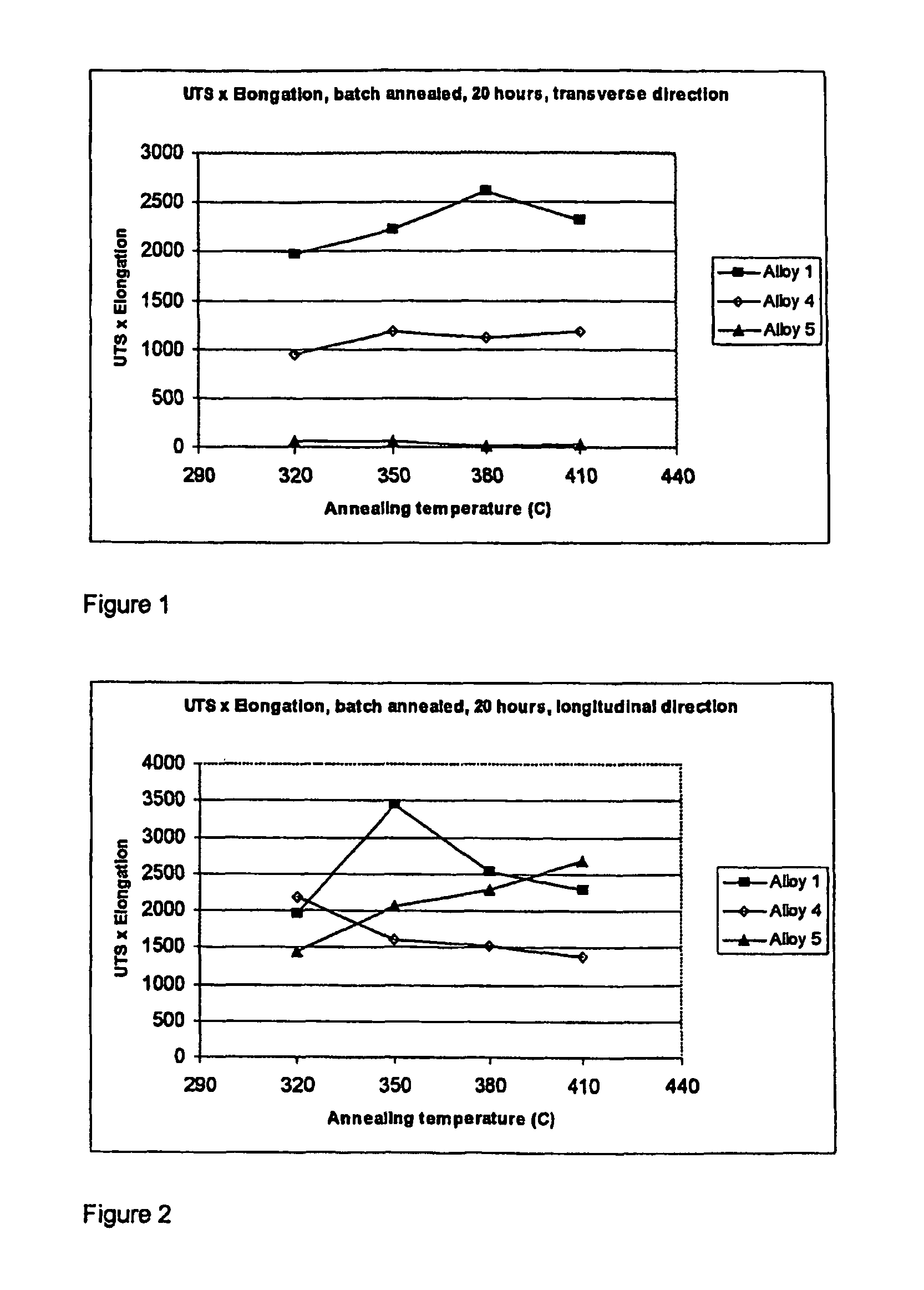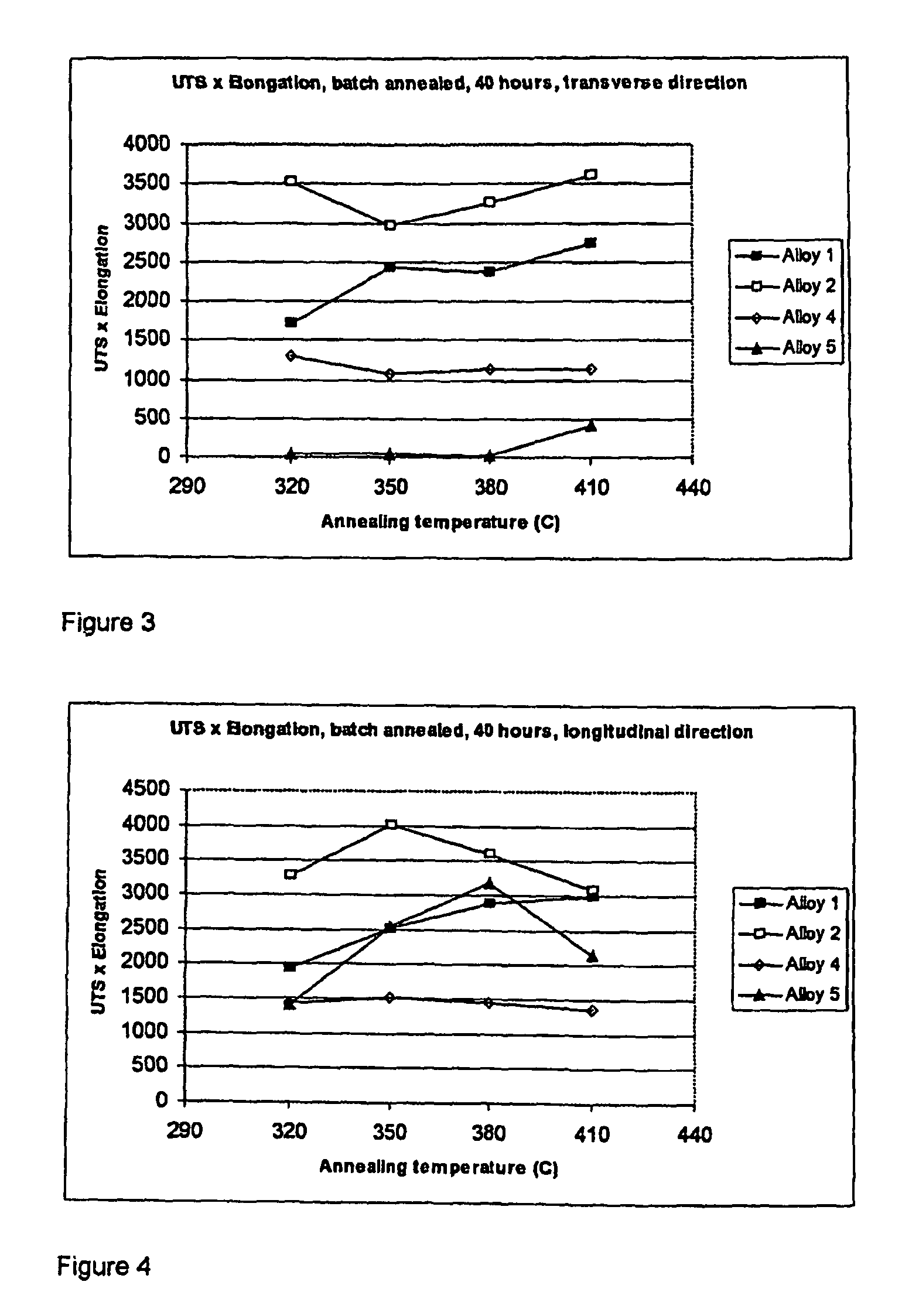Aluminium foil alloy
a technology of aluminum foil and alloy, applied in the field of aluminum alloy products, can solve the problems of reducing casting productivity, difficult to roll the foil down to the final gauge, and containing alloys, and achieve good mechanical properties
- Summary
- Abstract
- Description
- Claims
- Application Information
AI Technical Summary
Benefits of technology
Problems solved by technology
Method used
Image
Examples
example 1
[0071]Table 1 summarises the alloy compositions investigated. Alloys 1 and 2 are alloys within the scope of the invention. Alloy 4 is an AA8011 type alloy with Fe towards the lower end of the composition range, i.e. similar to products commercially available, but with an addition of Mn. Alloy 5 is an alloy according to the prior art WO 03 / 069003. For each composition the other elements were <0.05 each and <0.15 in total with the balance Al.
[0072]All alloys were continuously cast in a twin roll caster to the gauges shown in Table 1. They were then cold rolled on a lab-scale cold mill to a final gauge of 150 μm without an interannealing step. Each cold rolled product of alloys 1, 4 and 5 was then subjected to batch annealing treatments at 320, 350, 380 and 410° C. for periods of 20, 40 and 60 hours. Alloy 2 was batch annealed at these temperatures for a duration of 45 hours. Alloy 5 in particular, was found to have very inconsistent mechanical properties due to a completely different ...
example 2
[0078]Alloy 1 was continuously cast in a twin roll caster to the same gauge as in Table 1 and then cold rolled on a lab-scale cold mill to a gauge of 1.5 mm. At this point, some samples were subject to an interanneal and others were not. For those interannealed, the heat up rate was 50° C. per hour and they were held at a temperature of 320° C. for 4 hours. They were then air-cooled. All samples were then cold rolled to a final gauge of 210 μm. Samples of the cold rolled product, with and without the interanneal, were subjected to four final batch annealing treatments. All the anneals were for a duration of 4 hours and at temperatures of 250, 300 and 350° C.
[0079]The processing route with an interanneal at 320° C. and the final anneal 300° C. reflects the recommended production route from WO 02 / 064848. The mechanical properties of alloy 1 after these treatments are given in Table 5 and FIGS. 8 to 13. They show there is a significant difference between the mechanical properties attai...
example 3
[0085]In order to demonstrate the typical level of properties achievable on an industrial scale and at different gauges, alloy 2 was continuously cast by twin roll casting to the same gauge as in Example 1 and cold rolled on an industrial cold mill to gauges of 78, and 116 μm without interanneals using conventional cold rolling pass schedules. The cold rolled product of gauge 78 μm was batch annealed at 350° C. for 25 hours and the 116 μm gauge product was annealed at 320° C. for 30 hours. The mechanical test results are shown in Table 7.
[0086]
TABLE 7Gauge (μm)TL78YS112110UTS138143E2324UTS × E31743432116YS125126UTS156158E28.930UTS × E4508.44740
[0087]Whilst Examples 1 and 2 illustrate the relative advantages of the inventive process as applied to alloys 1 and 2 over the prior art, this Example illustrates the kind of properties attainable in full industrial production.
[0088]Lab-scale cold rolling, as used in Examples 1 and 2, involves different thermal and strain conditions. In an in...
PUM
| Property | Measurement | Unit |
|---|---|---|
| temperature | aaaaa | aaaaa |
| temperature | aaaaa | aaaaa |
| temperature | aaaaa | aaaaa |
Abstract
Description
Claims
Application Information
 Login to View More
Login to View More - R&D
- Intellectual Property
- Life Sciences
- Materials
- Tech Scout
- Unparalleled Data Quality
- Higher Quality Content
- 60% Fewer Hallucinations
Browse by: Latest US Patents, China's latest patents, Technical Efficacy Thesaurus, Application Domain, Technology Topic, Popular Technical Reports.
© 2025 PatSnap. All rights reserved.Legal|Privacy policy|Modern Slavery Act Transparency Statement|Sitemap|About US| Contact US: help@patsnap.com



